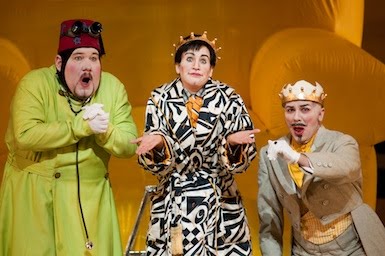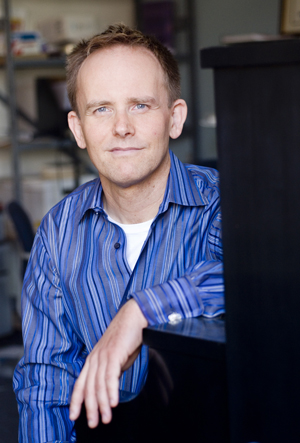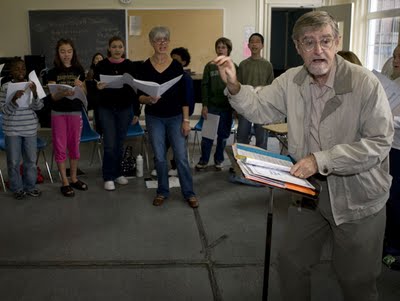Chabrier's L’Étoile Shines Bright for Austin Lyric Opera!

Labels: Austin Lyric Opera, classical music blog, Emmanuel Chabrier, Long Center, L’Étoile

Labels: Austin Lyric Opera, classical music blog, Emmanuel Chabrier, Long Center, L’Étoile

I must confess that I have a soft spot for thematic concerts; for while I admire virtuosity and outstanding musicality as much as anyone, I also want to see that performers have taken the trouble to do their homework, and that they have considered the intellectual implications of what they are presenting to the public. Choral conductor Craig Hella Johnson has practically written the book on how this should be done and his Christmas at the Carillon program, 2009 edition, featuring the choral group known as Conspirare, was just the latest chapter.
Before I talk about the performance I heard, some clarification may be useful. This concert was not “at the Carillon”, but at the Long Centre for the Performing Arts - seating 2400 - in downtown Austin, Texas. The Carillon is a small chapel - seating approximately 150 - in west Austin where Conspirare regularly presents some of its Christmas concerts.
Interweaving of Familiar and Unfamiliar Constructs Message
If I tell you that this concert included some familiar Christmas carols, I would be giving you information that is almost beside the point. What made this concert memorable was not so much the familiar but the unfamiliar music presented, and even more importantly, the way in which music and text were woven together over the course of the evening.

Craig Hella Johnson (photo: right) had an overarching concept for this concert. It was basically quite simple in its message: souls losing their way, lost in darkness, finding the light and achieving happiness. This simple message, however, was carefully constructed and delivered in the most non-confrontational and non-denominational way possible; he let the words and the music speak for themselves.
While there was a certain low-key sameness about the pieces chosen, ennui was avoided by mixing musical and textual genres. The work of ‘classical’ composers like Stephen Paulus, Handel and John Rutter was mixed with pop music by Mary Chapin Carpenter and Stevie Wonder, Broadway music by Lerner and Loewe and gospel music - ancient and modern. Patrice Pike, a popular Texas rock star, was a featured guest artist on the program.
What I liked most about the pop music, was the way in which Johnson stripped these songs of their high decibels and ubiquitous guitars and percussion, and so revealed the beauty and meaning of the words and the originality of the melodies.
In all this music, the twenty-three members of Conspirare – from the Latin “con” and “spirare” rendered as “to breathe together” – demonstrated their extraordinary skills as both soloists and choral artists.
Speaking of Light...and Togetherness
Johnson had obviously been preparing this concert for a long time and had considered every detail. Well, almost every detail. It was a fine idea to present the concert not only without intermission, but also without any breaks for applause until the mid-point. It was also a fine idea to provide the audience with the complete text for every piece performed – that’s twenty pages of text! Much of the text is beautiful and thoughtful poetry that must be seen and not just heard to be appreciated, but somebody dropped the ball and in so doing undermined much of what Craig Hella Johnson had so carefully planned: the house lights were turned off for the entire concert! There was no way members of the audience could read the program.
There is another element that unfortunately limited the impact of Johnson’s vision on this occasion. This was an intimate program, featuring mostly quiet and thoughtful music. In the small but resonant confines of the Carillon chapel, my guess is that the audience would have felt enveloped by the music and the whole experience. The Long Center, on the other hand, is dry as a bone and its very nature is to distance performers and audience from each other.
Naturally, performers always want to reach larger audiences, but sometimes enlarging the space diminishes the experience. Christmas at the Carillon might work in a space as large as the Long Center, but Johnson will have to make some adjustments. Perhaps more amplification and perhaps more instrumentalists would help. In the larger space the meditative quality of text and music can be easily lost.
I also felt that at times the concert came perilously close to new age blandness. Again, this was largely a function of the large hall. In this space Johnson might consider adding some more rousing pieces, spoken readings and a touch of humor now and again.
A case in point: Johnson chose to end the concert with a dream sequence version of “I could have danced all night” from Lerner and Loewe’s My Fair Lady. Bits of this familiar song were interwoven with Christmas words and music and elements of what had come before in the concert. It seemed to me, however, that what was needed was more like the original version of “I could have danced all night” with its ecstatic celebration of love and joy.
Johnson ended this concert with a sort of bittersweet smile when a joyous outburst might have sent the audience away feeling rejuvenated.
Conspirare CD Nominated for Grammy Award
Being the thoughtful and creative man that he is, I am sure Craig Hella Johnson has already begun processing the results of this year’s Christmas at the Carillon and that he will soon begin building an even deeper and more multi-faceted program for 2010.
Conspirare is already one of the finest and innovative choral ensembles in the country and with Johnson at the helm, its reputation can only continue to grow. Anyone wanting to know what the excitement is about, should investigate Conspirare’s most recent CD, Company of Voices: Conspirare in Concert (Harmonia Mundi HMU 907534), which was just nominated for a Grammy in the category “Best Classical Crossover Album”. This concert is also available on DVD (Harmonia Mundi HMD 9907535).
Paul E. Robinson is the author of Herbert von Karajan: the Maestro as Superstar, and Sir Georg Solti: His Life and Music, both available at Amazon.com.
Labels: Chttp://www.austinchronicle.com/binary/1048/arts_feature1-4.jpghristmas at the Carillon, classical music blog, Conspirare Symphonic Choir, Craig Hella Johnson, Long Center

The concert began with Mendelssohn's Incidental Music to Shakespeare's play A Midsummer Nights Dream (MND), programmed as part of the ASO's ongoing celebration of the 200th anniversary of the composer's birth. In this performance, the ASO was joined by the Conspirare Symphonic Choir.
From the Incidental Music that he had composed for Shakespeare's play, Mendelssohn later extracted a purely orchestral suite comprised of some of his best-loved music, including the glorious 'Wedding March' which has ushered millions of happy couples out the door of a church into a life of 'wedded bliss'.
Maestro Bay chose to add to Mendelssohn's orchestral suite some other bits and pieces from Mendelssohn's MND Incidental Music. The problem is that these bits are ,well - incidental, and don't make a lot of sense on their own without some of the text they were meant to support.
For me, the best options are, either 1) to play the suite of stand-alone orchestral pieces, or 2) to add some linking text comprised of narration and/or spoken excerpts from the play.
Be that as it may, Bay and his musicians played the music very well indeed. The horn and flute solos were not impeccable, but the style of playing was impressive. I particularly liked Bay's tempo for the scherzo, which is marked Allegro vivace and not Presto, as too many conductors seem to think. Bay's comfortable tempo adeptly brought out the charm of the piece.
The brief vocal solos were a little shaky and the chorus occasionally lacked clarity and rhythmic precision, but overall this was a good night for Mendelssohn.
Eclectic Traditional: Words by Neruda, Music by Ratcliff
Cary Ratcliff has lived in Rochester, NY for many years and plays keyboards with the Rochester Philharmonic. He has produced a large body of work which includes, among other things, songs for Shakespeare's A Midsummer Night's Dream.
The poetry Ratcliff chose to set to music in Ode to Common Things is by Nobel Laureate Pablo Neruda, and dates from the years 1954-59.
Some years ago I became interested in Neruda and that interest deepened considerably after a visit to Chile in 2008. Then - as it happens - just this last week, during an ocean voyage, I read a fine biography of Neruda by Adam Feinstein.
Neruda is perhaps most widely known and admired for his love poetry, but during much of his life, he was a political activist and diplomat. An ardent communist, he got into all kinds of trouble with friends and opponents alike. At one stage, when the Chilean government sought to arrest him, Neruda was forced into hiding. He later escaped on horseback over the Andes into Argentina. In another period, he alienated friends by stubbornly continuing to support Stalin even after the dictator's monstrous crimes came to light.
Neruda died of prostate cancer in 1973, just after the heartbreak of seeing his friend Salvator Allende overthrown and probably murdered in a coup led by General Pinochet. Neruda's funeral procession became one of the first public protests against the Pinochet government.
Neruda wrote numerous odes, but the Ode to Common Things is perhaps exceptional. An analysis and celebration of everything we take for granted in our lives, Neruda's poetry in this piece is perceptive, surprising, beautiful, sad and funny - often all at the same time. And so too is Ratcliff's music. In fact, when the poetry and the music are combined, there is almost too much sound and information to comprehend - at least at first hearing.
Fortunately, for this performance, Neruda's poetry was made available to the audience as an addition to the printed program. Unfortunately, when words are set to music they are often elongated to the point of being unrecognizable, especially when the tempo is quick, and so the tiny font size (7-8pt?) used in the program accentuated the difficulty of digesting large blocks of text in time to appreciate its particular musical expression.
These are problems, however, that will likely disappear with repeated hearings as one becomes more familiar with this complex piece. And let me be clear about this: Ratcliff's Ode to Common Things deserves repeated hearings.
Ratcliff composes in a style that I would describe as 'eclectic traditional'. The harmonies are traditional but the ways in which voices and instruments are used and combined are decidedly original.
In a choral work based on Chilean poetry, most composers would go all out with Latin rhythms. The orchestration would include a good deal of Latin percussion and bits of tango and samba would be everywhere. Ratcliff's composition is more subtle; its Latin elements are never predominant.
Ratcliff pays Neruda the compliment of respecting him as not only Chile's greatest poet, but also as a man whose thoughts and words have universal significance.
Power and Poetry: Chorus, Orchestra and Soloists Deliver!
Singing in the original Spanish, the Conspirare Symphonic Chorus, prepared by Craig Hella Johnson, was wonderful. The nearly 100 voices handled the tricky rhythms and textures with both finesse and enthusiasm.
Soprano Ava Pine, mezzo-soprano Dana Beth Miller and tenor Bryan Griffin were all excellent. Miller was particularly impressive in her duet with acoustic guitar in 'Ode to the Guitar'.
Maestro Peter Bay is to be commended not only for introducing Ratcliff's Ode to Common Things to Austin, but also for conducting it with extraordinary technical command and acute sensitivity to the myriad expressive demands of the piece.
A good night for Mendelssohn! A great night for Pablo Neruda, Cary Ratcliff and Peter Bay.
As you Like it!
After hearing a work like Ode to Common Things, listeners may want to read more poetry by Pablo Neruda and listen to other pieces composed by Cary Ratcliff. They may also want to watch a beautiful film about Neruda during a period of exile when he lived in Italy, and make the acquaintance of some Neruda songs by another composer, Peter Lieberson.
Labels: "Ode to Common Things", Austin Symphony Orchestra, Cary Ratcliff, classical music blog, Conspirare Symphonic Choir, Long Center, Pablo Neruda, Paul E. Robinson
Labels: Austin Symphony Orchestra, bruckner, classical music blog, Long Center, violinist Chee-Yun